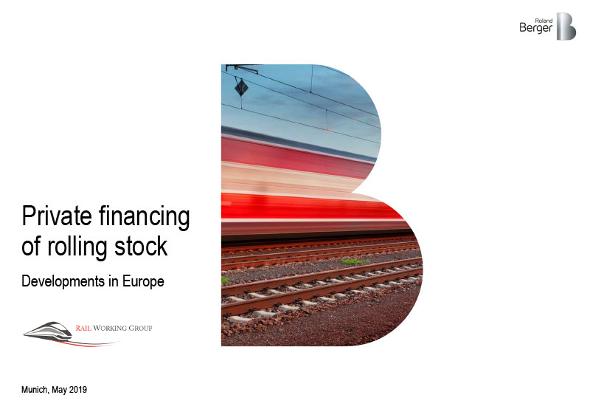

Rolling stock: Growth of private financing continues
Private financing of rolling stock will also play a growing role in Europe
In the period 2015 to 2017, private investors financed almost a quarter of the total volume of rolling stock orders. This is one finding from the study “Private financing of rolling stock – developments in Europe,” which Roland Berger prepared for the Rail Working Group. This is a significant increase over the period 2011 to 2013, when orders accounted for 13% of total orders, with a slight increase of 3% over the period 2013 to 2014 (then 20%).

The term “rolling stock” in the rail transport industry refers to any vehicles that move on a railway. In view of these figures, Roland Berger assumes that the private financing of rolling stock will play a growing role in Europe. In the medium term 2021 to 2023, private investors could provide up to 31% of the total annual investment volume. In Europe, this amounted to 14.95 billion euros in the period under review (2011-2013: €13.33 bn; 2013-2015: €12.12 bn).
"Private financing will be an increasingly important source of finance for rolling stock orders in the 2021-2023 timeframe "
More liberalization, more private investment
The study also shows that countries with major rail liberalization programs – including the UK and Germany – will continue to be the main markets for private finance, strengthening the link between market liberalization and private capital. For example, the UK rail market was one of the first to be liberalized in 1994. The result: a high liberalization index of 99% and a share of private financing of 58%.
According to industry insiders, however, progress is far too slow as the private sector remains reluctant to invest in rail equipment, and public sector governments and operators are reluctant to exploit the opportunities and disciplines of shifting the financial burden to the private sector . As a result, there is an urgent need to create the conditions to secure existing private credit and attract more private finance at affordable prices. New initiatives, such as the Luxembourg Rail Protocol, should make this possible.
Over 11 billion euros from governments and government agencies
The study on the public and private financing shares analyzes 590 rail vehicle procurement projects in 23 European countries between 2015 and 2017, when the annual average order volume rose to 14.95 billion euros.
During this period, 11.5 billion euros was financed directly or indirectly by governments or government agencies (77% of the total), while 3.4 billion (23%) was provided by private investors. In Western Europe, private finance accounted for 23% of total rolling stock investment in 2015-2017, whereas in Eastern Europe, 20% of investment was privately funded. This shows a major increase in private funding in Eastern Europe: in 2011-2013, private finance only funded 11% of procurement by volume.
To download the study please click here .







